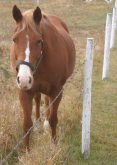REGINA – Tony and Ruth Hill are convinced about one thing.
That is the ability of the Belgian Blue to make a difference in the Canadian beef industry.
“These are for meat. That’s what they are all about,” said Tony beside his stall at the Canadian Western Agribition.
The Hills, who farm at Wiseton, Sask., keep a commercial herd, as well as purebred Belgian Blues. They plan to breed 25 Blue cows this spring.
There were 36 entries at Agribition to show the public how far the breed has come since it was imported to Canada in the mid-1970s. Belgian Blue breeders registered about 2,500 head last year.
Read Also

Beef check-off collection system aligns across the country
A single and aligned check-off collection system based on where producers live makes the system equal said Chad Ross, Saskatchewan Cattle Association chair.
Most breeders are interested in selling terminal sires to commercial cattle producers who are looking to add some muscle to feedlot steers and heifers. It is estimated the crossbred calves inherit about 50 to 60 percent of the muscling ability.
The Hills have crossed these Belgian imports with a variety of other breeds. They like the Angus cross because they add marbling and the Blues add muscle. A Simmental cross also works well. The calves are highly efficient feed converters and receive plenty of milk from their Simmental dams.
These big Europeans are the Arnold Schwar-eneggers of the cattle world with bulging, extreme muscling in their hind and front quarters.
The breed was developed in Belgium at the turn of century by crossing big, beefy Shorthorn roans to multi-purpose animals used for milk, meat and draft.
Through selection they developed the Belgian Blue, which are predominantly white with splashes of blue black across their backs and sides.
The Europeans pushed this breed to more extreme muscling and often calves were delivered by caesarean section. When they are shown in Europe, the upper half of the butt end below the tail is shaved to the skin. This shows the full extent of muscle definition.
The muscling starts to develop after birth. Belgian Blues are actually a small-boned breed with birthweights around 75 pounds. In Europe breeders let the calves get bigger.
Canadian animals carry less of that extreme muscling and are bred for easier calving since few cattle producers here want the extra labor at calving time.
“We’ve probably calved out 1,000 cows and we have never had a C-section in our commercial cows,” said Hill.
The Hills started in 1990 with a Belgian Blue embryo and do not attempt to breed up their cattle. They feel they work as crossbreds.
In the beginning the Blues were hard to sell, the Hills said, but sales have become easier as commercial people began see the breed’s performance.
The breed is popular in Great Britain. At one time 70 percent of British beef came from the dairy herd. When bovine spongiform encephalopathy infected more than half the dairy population, cattle producers started switching to beef-producing cattle. Dairy producers have bred their milkers to Blues to produce better beef animals that are more marketable.

















